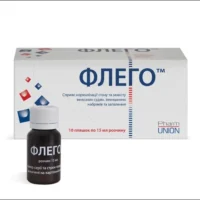Description
Flebodia Coated Tablets 600 mg. №30
Ingredients:
Each coated tablet contains 600 mg of diosmin.
Mechanism of Action:
Diosmin, the active ingredient in Flebodia tablets, exerts its pharmacological effects by acting as a venotonic and vasoprotective agent. It enhances venous tone, reduces venous distensibility, and decreases venous stasis, thereby improving venous circulation and overall venous function.
Pharmacological Properties:
Diosmin in Flebodia tablets exhibits venoprotective, anti-inflammatory, and antioxidant properties. It helps alleviate symptoms associated with venous disorders by improving venous tone and reducing inflammation and oxidative stress in the blood vessels.
Indications for Use:
Flebodia tablets are indicated for the treatment of venous circulation disorders, including varicose veins and chronic venous insufficiency. They help relieve symptoms such as leg pain, heaviness, and edema associated with venous insufficiency.
Contraindications:
Avoid using Flebodia tablets if you have a known allergy to diosmin or any other components of the product. Consult your healthcare provider before starting treatment if you have any concerns or known allergies.
Side Effects:
Common side effects of Flebodia tablets may include gastrointestinal disturbances. If you experience any severe adverse reactions, discontinue use and seek medical advice promptly.
Usage Instructions:
The recommended dosage is one tablet per day, preferably taken in the morning. Swallow the tablet whole with a glass of water; do not crush or chew it.
Benefits Compared to Analogues:
Flebodia tablets offer a unique combination of diosmin’s venotonic and vasoprotective properties, providing effective relief for venous circulation disorders with a favorable safety profile compared to alternative treatments.
Suitable Patient Groups:
Flebodia tablets are suitable for adult patients, including the elderly, who require treatment for venous circulation disorders. Consult a healthcare professional for guidance on the use of Flebodia in specific patient populations, such as children or pregnant individuals.
Storage and Shelf Life:
Store Flebodia tablets in a cool, dry place away from direct sunlight. Keep the product out of reach of children. Check the expiration date on the packaging and do not use the tablets beyond the stated shelf life.
Packaging Description:
Flebodia tablets are supplied in a package containing 30 coated tablets, each tablet containing 600 mg of diosmin. The packaging is designed to maintain the quality and integrity of the product until the expiration date.
Scientific Evidence:
Studies have demonstrated the efficacy of diosmin in improving symptoms of chronic venous insufficiency, including leg pain, heaviness, and edema. Diosmin’s venotonic and anti-inflammatory properties contribute to its therapeutic benefits in venous disorders.
Additional Information:
- Pregnancy and Lactation: Consult your healthcare provider before using Flebodia tablets if you are pregnant or breastfeeding.
- Adverse Reactions: Common side effects may include gastrointestinal disturbances. Discontinue use if any severe reactions occur.





